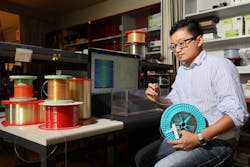Fiber-optic sensor uses acoustic waves to detect surrounding substances
Researchers at EPFL Swiss Federal Institute of Technology (Lausanne, Switzerland) have created a type of optical fiber that uses so-called forward-stimulated Brillouin scattering (FSBS) to sense whether the surrounding medium is gas or liquid; if liquid, it can sense the type of liquid.1 FSBS produces resonating transverse acoustic waves to sense acoustic impedances of media outside the fiber. The EPFL researchers have greatly increased the position resolution for the FSBS technique; for example, a 730-m-long fiber has a spatial resolution of 15 m. The study was conducted by the Group for Fibre Optics (GFO) run by Luc Thévenaz within EPFL's School of Engineering.
A glass optical fiber transmits light that varies according to four parameters: intensity, phase, polarization, and wavelength. These parameters are altered when the fiber is stretched or the temperature changes, enabling the fiber to act like a sensor, for example detecting cracks in structures or abnormal temperatures. But up to now it was not possible to determine what was happening around the fiber without having light escape the fiber, which disrupts its path. The FSBS method uses a hyperfrequency acoustic wave that regularly bounces off the fiber's walls; the echo varies at different locations depending on the acoustic impedance of the material the wave comes into contact with. This imprint is so faint that it hardly disturbs the light propagating within the fiber. The method could be used to sense what is going on around a fiber and send light-based information at the same time.
The researchers have already immersed their fibers in water and then in alcohol, before leaving them out in the open air. Each time, their system was capable of correctly identifying the change in the surroundings. "Our technique will make it possible to detect water leakages, as well as the density and salinity of fluids that come into contact with the fiber," says Thévenaz. "There are many potential applications."
Spatial and temporal detection
The technique is phase-sensitive and therefore very spatially accurate. "For the moment, we can locate disturbances to within around ten meters, but we have the technical means to increase our accuracy to one meter," says Thévenaz. The concept of using acoustic waves in optical fibers initially came from the team's partner researchers at Bar-Ilan University in Israel. Joint research projects should follow.
Source: https://actu.epfl.ch/news/optical-fibers-that-can-feel-the-materials-around-
REFERENCE:
1. Desmond M. Chow et al., Nature Communications (2018); https://doi.org/10.1038/s41467-018-05410-2.
About the Author
John Wallace
Senior Technical Editor (1998-2022)
John Wallace was with Laser Focus World for nearly 25 years, retiring in late June 2022. He obtained a bachelor's degree in mechanical engineering and physics at Rutgers University and a master's in optical engineering at the University of Rochester. Before becoming an editor, John worked as an engineer at RCA, Exxon, Eastman Kodak, and GCA Corporation.

